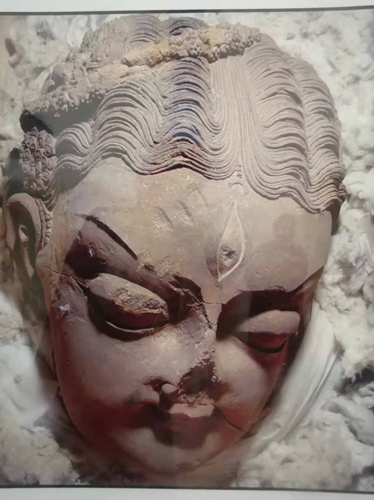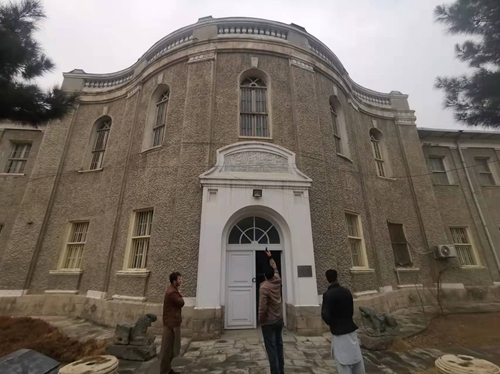Exclusive visit to the reopened National Museum of Afghanistan

A Buddhist statue head at the museum Photo: Courtesy of Yu Yong

A Koran on display at the museum The National Museum of Afghanistan in Kabul Below: A Buddhist statue head at the museum Photos: Courtesy of Yu Yong
Appearing rather inconspicuous a building from the outside, the National Museum of Afghanistan actually houses one of the most precious and representative cultural collections that can be found in Afghanistan, or even the world.
Located in the capital of Kabul, the building housing the museum has stood fast for more than 100 years. However, due to decades-long wars across the country, the museum has witnessed the theft and destruction of many of its relics, as well as, on some happy occasions, their return.
During the quite calm takeover of the Taliban-led caretakers in mid-August, the museum had to close for a period of time. The museum now reopens after almost four months, welcoming tourists from around the country and the globe.
The Global Times visited the museum, accompanied by the museum’s deputy director Muhammad Yahya Mohebzada.
After a simple security check by Taliban soldiers and the purchase of a 100 afghani (97 cents) ticket, the Global Times reporter stepped into the museum.
“It is cheaper for locals,” Mohebzada noted.
“But due to the poor economy, it is still a burden for locals to pay for tickets. Still we have seen many people, such as college students, coming in groups here to learn the history.
“Yesterday there was a group of some 150 college students who came to see the collections.”
Not just Islamic relics
As a place with 1,000 years of history, Afghanistan has been home to many different cultures, including Buddhist, Persian and Islamic civilizations. Therefore, the cultural relics from the region are impossible to ignore, even when put on the world stage.
The Taliban caretakers’s attitude toward these relics is that they must all be protected no matter the differences in their cultural or religious backgrounds.
About 15 to 20 percent of the exhibits are of Islamic heritage, the rest are non-Islamic relics such as Buddhist statues and statues from the Kushan Kingdom (135BC-AD375) founded by Emperor Kanishka in the Bactria region of northern Afghanistan. Statues of Hindu deities, which stand in sharp contrast to the Islamic statues, can also be seen throughout the museum.
In addition, oil paintings created by domestic painters, screen partitions from China and porcelain vases from its Qing Dynasty (1644-1911) can all be seen in this two-story building.
Funded by the Taliban
“The government holds an open attitude toward the management of the museum and hasn’t posed any restrictions over this place,” a staffer told the Global Times.
“The Ministry of Information and Culture of the Taliban acknowledged that they are committed to preserving the cultural sites, historic antiquities and monuments of Afghanistan,” wrote a report from The Khaama press agency, which is based in Afghanistan.
The day after the Taliban entered Kabul, they took over the museum, clearing out all staff members and preventing them from entering the building.
A month later, the Taliban handed the museum back to the management team, stepping back to only provide security for the building.
“No antiquities have been stolen from the museum since the takeover,” recalled Mohebzada.
For security reasons as well as the limited show space at the museum, only a portion of the collection is on display. A majority of the collection is currently in storage in the basement of the museum, while the most precious relics are kept inside the former presidential residence.
When asked if the museum was receiving any financial support from any NGOs or other organizations, Mohebzada told the Global Times that there are currently no channels in the museum to accept financial support from any international organizations.
He noted that the museum currently has more than 80 staff members, comprised of both men and women, and that their salaries are paid entirely by the Taliban government.
Close ties with China
As the country’s biggest museum, both in terms of floor space and the size of its collection, the 100-year-old museum has encountered numerous difficulties in keeping its relics safe due to decades of war.
From 1992 to 1995, the museum lost nearly every item in its collection and only half, more than 50,000 items, were later recovered.
To avoid any further loss from war, a large portion of the collection are now being exhibited inside the museum once traveled overseas on a world tour that included a two-year-long exhibition in China.
Mohebzada, who has been working at the museum for more than 30 years, accompanied the Afghanistan treasures as they conducted a national tour within China from 2017 to 2019.
“I communicated a lot with my counterparts in China. The country made a deep impression on me, ” he said, recalling his experiences during the tour.
“I thank them for their efforts to protect Afghanistan’s heritage.”
In March 2017, the relics made their debut in China.
They were first exhibited in the Palace Museum in Beijing, after which the precious cultural relics were “relayed” on display in museums throughout China, such as in the provinces of Gansu, Henan and Hunan.
A certificate from a museum in Hunan was presented to Mohebzada to thank him for tour these relics in China.
The certificate remains on display on a shelf in his office at the National Museum of Afghanistan, witnessing the friendship and cultural exchanges between China and Afghanistan.
Noting the difficulties facing the museum in Afghanistan, the Palace Museum in Beijing published a proposal in November signed by 21 reputed academics from China and abroad that called for international attention and support for Afghan cultural heritage and from local cultural experts.
Shan Jixiang, former director of the Palace Museum, told the Global Times that China is taking a more active part in protecting the international cultural heritage, and is willing to play a more important role in protecting cultural relics from Afghanistan, a country with unique treasures that have been long threatened by political turmoil.
A Koran on display at the museum Photo: Courtesy of Yu Yong

